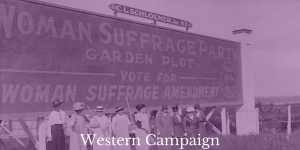Western Campaign for Suffrage

The student will examine why western states granted women’s voting rights long before a national amendment was passed. Students will use document analysis to answer a fundamental question: Why did Western states grant women voting rights before the rest of the nation?
15 minutes (The lesson can also be lengthened into a 45 minute class lesson. See below in “Guided Practice” section for optional class extension.)
Students will be able to answer the question: Why did Western states grant women voting rights before the rest of the nation?
For gifted/honors students or if class time is limited, have the students research the background information ahead of time (previous class period) and bring their research to class. You can also print out the websites and distribute to the collaborative groups (see below).
- Laptops/Chromebooks (enough for the class)
- Poster Paper
- Chart Markers
- Starter/Hook: Have students list reasons why they think western states granted women the right to vote before the rest of the nation. Write the reasons on the board.
- Direct Instruction:
- Provide background on women’s suffrage movement from 1900 to 1920 to the class. Explain to students that women gained suffrage in western states before the 19th Amendment and that these states were used as examples of why women should be granted voting rights in other states.
- Use the NWHM’s “Crusade for the Vote” to provide background information:
- Guided Practice:
- Inform students that there were five key reasons that western states granted women voting rights before the rest of the country: immigration, propaganda, racism, statehood, and woman as virtuous citizen.
- Divide the class into five groups and assign each group a topic. Have the group get a piece of chart paper, markers, and laptops.
- Have students use the laptops to visit the Library of Congress websites to search for primary sources that reflect their topic:
- Have students print and paste or recreate by hand their document on the poster paper. Ask students to analyze their document with the 5WH Approach (Who? What? When? Where? Why? How). Have students look for evidence that the western states used issues of immigration, propaganda, racism, statehood, and woman as a virtuous citizen to argue for voting rights.
- Have each group present their topic and sources to the rest of the class.
- Students will write a follow-up response after presentations on whether or not the use of these topics was effective in gaining voting rights. Have students imagine that they are one of the groups that westerners wanted to limit. How might a Chinese immigrant, Mormon polygamist, or Native American respond to these arguments?
- Optional: To extend this activity, have students look at issues in modern society and reflect on whether these arguments continue to be used. Students can bring in articles or write a free response.
UCLA Social Studies Standard 1C: Specify the issues raised by various women and how mainstream Progressives responded to them. [Consider multiple perspectives]
UCLA Social Studies Standards Available Here
Common Core Alignment
CCSS.ELA-LITERACY.RH.9-10.1 - Cite specific textual evidence to support analysis of primary and secondary sources, attending to such features as the date and origin of the information.
CCSS.ELA-LITERACY.RH.11-12.1
Cite specific textual evidence to support analysis of primary and secondary sources, connecting insights gained from specific details to an understanding of the text as a whole.
